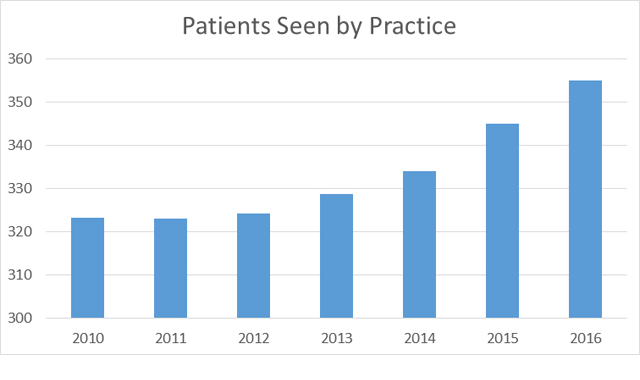The importance of patient acquisition in a competitive market
As attracting new patients and keeping the current active patient base robust is imperative for the financial health of the practice, dentists need to know their patient numbers and how those numbers compare to national averages.

Maintaining a current patient base and bringing in new patients requires careful attention to patient care, communication and retention. Many dentists find themselves competing with other practices for a limited pool of patients in a certain geographical area.
With little to no cost for switching, patients are often quick to change dentists due to convenience, or financial or personal factors, even when they are being provided exceptional oral healthcare. As attracting new patients and keeping the current active patient base robust is imperative for the financial health of the practice, dentists need to know their patient numbers and how those numbers compare to national averages.
More from the author: 5 ways to manage seasonality trends in your practice
Sikka Software collects data from thousands of opt-in dental practices across the nation. The data is HIPAA and HITECH compliant and is free of any patient or practice identifying information. Data is collected to with the goal of providing the dental industry and practitioners the information required to benchmark practice performance and plan for managing patient flow and growth. More information can be found here.
Continue to the next page to see the stats...

Dentist new patients
Over the past six years, individual practitioners have, on average, seen a significant increase in the number of new patients seen each month. In 2010, during the tail end of the Great Recession, dentists were seeing, on average, 19 new patients each month.
Trending article: How seasonality affects revenue in the dental practice
As patients recovered financially, gained more disposable income and earned dental benefits through employment, the number of new patients increased significantly with the fastest growth happening between 2014 to 2015. As of summer 2016, dentists are seeing an average of 23.5 new patients each month, representing significant opportunities for revenue gain and improved community oral health.



Total practice new patients
The remainder of this article will focus on new and returning patient visits for the entire practice.
Trending article: 5 ways to stop revenue-killing attrition in your dental practice
The average practice size is a small group with two to three dentists, so there is a cumulative new patient growth effect. When each dentist is seeing more new patients, the practice is also seeing more new patients as a whole. In 2010, practices welcomed an additional 40.4 new patients each month but by 2016 the number rose to an additional 48.2 new patients. Based on the upward trend of practice new patient growths, 2016 is expected to exceed the 2015 average through increases in new patients during the busy fall and winter months.



Patients seen by practice
The total number of patients, new and returning, seen each month at a practice is limited by space and labor capacities.
More from the author: Trends in hygiene care from 2008-2015
However, with increases in demand, dentists can look at expanding the number of chairs and hiring more skilled and semi-skilled laborers. In 2010, practices were seeing an average total of 323 patients each month. This number has grown significantly to 355 patients per month in 2016, indicating higher demand and a strong outlook for dentistry professionals who are hoping to start their own practice or grow their current practice.



Active patients per practice
Maintaining the practice’s current patient base is also important, as acquiring new patients is often costlier than patient maintenance efforts, and ensuring continuing good oral health is part of the mission of a provider. Active patients are most often defined as having visited the practice in the previous 18 months.
Trending article: The latest revenue data for dental practices across the nation
In 2010, the average active patient pool was 2,179 with a fairly steady growth through 2014. Between 2014 and 2015, there was a large increase in the average active patient pool, likely driven by the influx of new patients as well as returning patients. By 2016, the average number of active patients is 2,421, demonstrating that many more patients are receiving dental care across the United States.



Conclusion
Despite best efforts, dentists may struggle with acquiring new patients at a rate that allows for maintaining their current active patient base or growing practice revenue and services. Although trends from the previous six years indicate that economic recovery has had a positive effect on new patient growth, dentists must actively acquire patients to continue the positive upward trend.
More from the author: 5 ways for your dental practice to keep your momentum
Growing and maintaining and growing patient bases is imperative to practice health. Sikka Software has created a free app called Practice Mobilizer to help dentists track and manage patient flow. Dentists can find out more by clicking here or by attending our annual Summit in Monterey, California. This is a great opportunity to learn how to use practice data and analytics while meeting industry experts and gaining CEUs. More information is available here.

Product Bites – September 15, 2023
September 15th 2023With half-a-dozen new products, this is a busy week for Product Bites. This week we feature the debuts of ClinicCAD from Medit, Multi-Unit Abutments from Neoss Group, CURIE Plus from Ackuretta, Samba robotic toothbrush from CURAPROX, Remedo AI website design, and the CA 1:2.5 Micro-Series handpiece attachment from Bien Air. [6 Min]